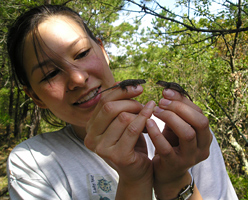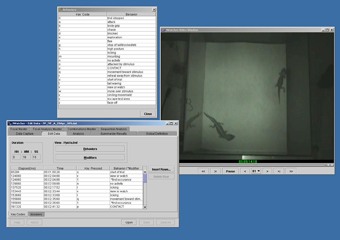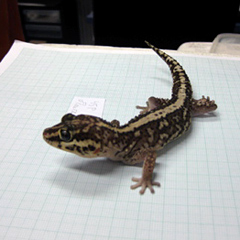Golinski Investigates Evolution of Sexual Dimorphism in Lizards
 Sexual dimorphism is pervasive among animals. Consider the large antlers used during combative sparring among male deer, powerful muscles used in the athletic wing-snap courtship display of golden manikin birds, and the bright blue coloration exhibited by male Eastern Fence Lizards. In many cases, these phenotypic differences are not due to genotype but rather to sex differences in gene regulation. Put another way, sex hormones, such as testosterone, are key in determining sex-specific traits.
Sexual dimorphism is pervasive among animals. Consider the large antlers used during combative sparring among male deer, powerful muscles used in the athletic wing-snap courtship display of golden manikin birds, and the bright blue coloration exhibited by male Eastern Fence Lizards. In many cases, these phenotypic differences are not due to genotype but rather to sex differences in gene regulation. Put another way, sex hormones, such as testosterone, are key in determining sex-specific traits.
Alison Golinski (left), a student in Henry John-Alder's lab, is conducting experiments to gain insight into how testosterone is related to the observed diversity of male-typical traits in eyelid (eublepharid) gecko lizards. Males of most species of eyelid geckos are typically larger, have broader heads, and are more aggressive than females, but some species have evolved different patterns (see figure).

Alison's studies involve three species in which some of these traits don't follow the typical pattern of expression: Yucatan banded gecko (Coleonyx elegans), Lichtenfelderi's gecko (Goniurosaurus lichtenfelderi), and the Madagascar ground gecko (Paroedura picta). Alison's primary objectives are to determine 1) which traits are regulated by testosterone in each species, and 2) if testosterone plays the same (or different) role in species with different patterns of trait expression.
Alison measures the expression of traits, both morphological and behavioral, in response to the manipulation of testosterone levels. Her behavioral studies focus on social interactions between hormone-manipulated geckos of both sexes. Because these species are nocturnal, her observations are done at night using night-vision video technology. To conduct the behavioral trials, Alison was awarded a Fulbright scholarship to travel to Charles University in Prague, Czech Republic, where she worked with Lukáš Kratochvíl and his students. Dr. Kratochvíl is an expert on life-history, behavior and sexual dimorphisms in eyelid geckos, and he maintains breeding colonies of the species of interest.
Because these species are nocturnal, her observations are done at night using night-vision video technology. To conduct the behavioral trials, Alison was awarded a Fulbright scholarship to travel to Charles University in Prague, Czech Republic, where she worked with Lukáš Kratochvíl and his students. Dr. Kratochvíl is an expert on life-history, behavior and sexual dimorphisms in eyelid geckos, and he maintains breeding colonies of the species of interest.
In fall of 2010, Tracy Brynildsen (pictured, right) joined the project to assist with the analysis of behavioral trials. Tracy is a senior in Biological Sciences completing her honor's research project. She uses specialized software to analyze the videos of the Madagascar ground geckos (pictured, below) - all 186 of them. Tracy will write her honors research thesis based on her analyses, and will defend her thesis for her B.S. in biology in April.
Alison, with her advisor Henry John-Alder and collaborator Lukáš Kratochvíl, has recently published an article in Hormones and Behavior entitled "Male sexual behavior does not require elevated testosterone in a lizard (Coleonyx elegans, Eublepharidae)." This species shows highly simplified sexual behavior in which male courtship has been lost. Alison's paper reported that behavior in males did not respond to experimentally manipulated levels of testosterone, the first such discovery among lizards. This finding is significant because it suggests that while testosterone regulates male sexual behavior in many species, testosterone may have no such effect in species in which the courtship phase of sexual behavior has been evolutionarily lost. 



